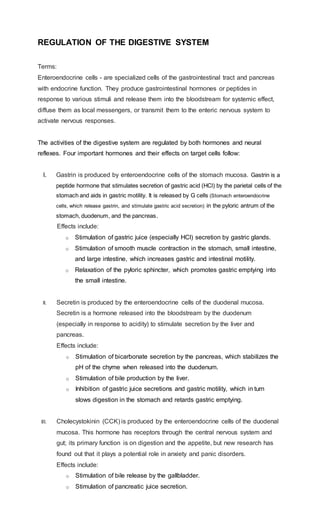
Regulation of the Digestive System
- 1. REGULATION OF THE DIGESTIVE SYSTEM Terms: Enteroendocrine cells - are specialized cells of the gastrointestinal tract and pancreas with endocrine function. They produce gastrointestinal hormones or peptides in response to various stimuli and release them into the bloodstream for systemic effect, diffuse them as local messengers, or transmit them to the enteric nervous system to activate nervous responses. The activities of the digestive system are regulated by both hormones and neural reflexes. Four important hormones and their effects on target cells follow: I. Gastrin is produced by enteroendocrine cells of the stomach mucosa. Gastrin is a peptide hormone that stimulates secretion of gastric acid (HCl) by the parietal cells of the stomach and aids in gastric motility. It is released by G cells (Stomach enteroendocrine cells, which release gastrin, and stimulate gastric acid secretion) in the pyloric antrum of the stomach, duodenum, and the pancreas. Effects include: o Stimulation of gastric juice (especially HCl) secretion by gastric glands. o Stimulation of smooth muscle contraction in the stomach, small intestine, and large intestine, which increases gastric and intestinal motility. o Relaxation of the pyloric sphincter, which promotes gastric emptying into the small intestine. II. Secretin is produced by the enteroendocrine cells of the duodenal mucosa. Secretin is a hormone released into the bloodstream by the duodenum (especially in response to acidity) to stimulate secretion by the liver and pancreas. Effects include: o Stimulation of bicarbonate secretion by the pancreas, which stabilizes the pH of the chyme when released into the duodenum. o Stimulation of bile production by the liver. o Inhibition of gastric juice secretions and gastric motility, which in turn slows digestion in the stomach and retards gastric emptying. III. Cholecystokinin (CCK) is produced by the enteroendocrine cells of the duodenal mucosa. This hormone has receptors through the central nervous system and gut; its primary function is on digestion and the appetite, but new research has found out that it plays a potential role in anxiety and panic disorders. Effects include: o Stimulation of bile release by the gallbladder. o Stimulation of pancreatic juice secretion.
- 2. o Relaxation of the hepatopancreatic ampulla and opening of the hepatopancreatic sphincter, which allows the flow of bile and pancreatic juices into the duodenum. IV. Glucose insulinotropic peptide (GIP) is produced and released by the enteroendocrine cells of the duodenal mucosa in response to the presence of the glucose in the small intestine. This hormone stimulates the pancreas to begin releasing insulin. Some researchers refer to this hormone as glucose‐dependent insulinotropic peptide (still maintaining the abbreviation of GIP; some also use GDIP). The second regulatory agent of the digestive system is the nervous system. Stimuli that influence digestive activities may originate in the head, the stomach, or the small intestine. Based on these sites, there are three phases of digestive regulation: 1. The cephalic phase comprises those stimuli that originate from the head: sight, smell, taste, or thoughts of food, as well as emotional states. In response, the following reflexes are initiated: i. Neural response: Stimuli that arouse digestion are relayed to the hypothalamus, which in turn initiates nerve impulses in the parasympathetic vagus nerve. These impulses innervate nerve networks of the GI tract (enteric nervous system), which promote contraction of smooth muscle (which causes peristalsis) and secretion of gastric juice. Stimuli that repress digestion (emotions of fear or anxiety, for example) innervate sympathetic fibers that suppress muscle contraction and secretion. ii. General effects: The stomach prepares for the digestion of proteins. 2. The gastric phase describes those stimuli that originate from the stomach. These stimuli include distention (enlargement) of the stomach (which activates stretch receptors), low acidity (high pH), and the presence of peptides. In response, the following reflexes are initiated: i. Neural response: Gastric juice secretion and smooth muscle contraction are promoted. ii. Hormonal response: Gastrin production is promoted. iii. General effects: The stomach and small intestine prepare for the digestion of chyme, and gastric emptying is promoted. 3. The intestinal phase describes stimuli originating in the small intestine. These include distention of the duodenum, high acidity (low pH), and the presence of chyme (especially fatty acids and carbohydrates). In response, the following reflexes are initiated:
- 3. i. Neural response: Gastric secretion and gastric motility are inhibited (enterogastric reflex). Intestinal secretions, smooth muscle contraction, and bile and pancreatic juice production are promoted. ii. Hormonal response: Production of secretin, CCK, and GIP is promoted. iii. General effects: Stomach emptying is retarded to allow adequate time for digestion (especially fats) in the small intestine. Intestinal digestion and motility are promoted.
